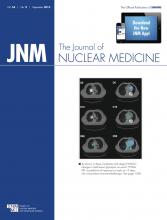REPLY: First, we would like to thank Dr. Kao for his elaborate comments regarding our article (1).
It is a matter of common sense that in cases of radioembolization, the determination of dose distribution is a challenging task because of the complexity of quantitative imaging and the limited availability of surrogate parameters for tissue (tumor) dosimetry.
Coming back to the blind men and the elephant, however, one should not mistake the pretherapeutic evaluation of intrahepatic 99mTc-macroaggregated albumin (MAA) distribution with the posttherapeutic distribution of 90Y microspheres. The work of Kao et al. (2) is a dosimetry study using the partition model and the 99mTc-MAA accumulation pattern to predict the accumulated dose in target regions. In Kao’s study of hepatocellular carcinoma patients published in 2012, he assumes that “…99mTc-MAA scintigraphy may be considered a ‘simulation study’ for 90Y resin microsphere predictive dosimetry” (supplemental data of (2)), yet he acknowledges in his letter that “99mTc-MAA is an imperfect surrogate for 90Y microspheres.” The latter assumption is well in line with the evidence from several other studies that investigated 99mTc-MAA and 90Y microsphere distribution in different tumor entities (3–6). Consequently, relating 99mTc-MAA distribution to the accumulated dose is a questionable practice.
In conclusion, we have the following major concerns about the comments made by Dr. Kao:
First, the study uses the partition model (2), which has been validated for dosimetry in only hepatocellular carcinoma patients (7). The basic assumption of the partition model is the equivalency between the accumulation pattern of the therapeutic agent (90Y-labeled microspheres) and the accumulation pattern of the diagnostic surrogate (99mTc-MAA). However, this equivalence has not been demonstrated for other tumor entities, especially not in colorectal carcinoma. Furthermore, several authors have reported discordant 99mTc-MAA and 90Y activity distributions (3–6).
Second, treatment planning should be based on a priori information to predict the intended response and total absorbed dose before therapeutic intervention as established in external-beam radiotherapy or brachytherapy. In contrast, using information from pre- and posttherapeutic examinations (99mTc-MAA SPECT or Bremsstrahlung SPECT, for example) represents a validation process.
We agree that advanced imaging protocols using, for instance, cone-beam CT, Bremsstrahlung SPECT/CT or 90Y PET/CT have an important role in the development of validation procedures for radioembolization. Nevertheless, these procedures do not compensate for the lack of an adequate diagnostic surrogate for pretherapeutic dosimetry.
In this regard, the conclusion of our study was that 90Y-radioembolization-therapy “…should not be withheld from patients with colorectal liver metastases lacking intratumoral 99mTc-MAA accumulation” (1).
Again, we thank Dr. Kao for his comments and discussion.
Footnotes
Published online Jul. 29, 2013.
- © 2013 by the Society of Nuclear Medicine and Molecular Imaging, Inc.







